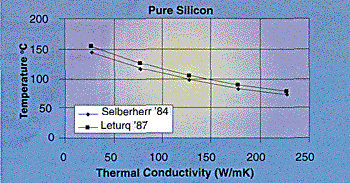The most important material within the semiconductor industry is Silicon. When dealing with electro-thermal device modelling, or the interpretation of fast transient techniques for the measurement of thermal impedance, thermal conductivity of Silicon is required. For steady state thermal analyses at the board and system level, however, accurate values are not required, because the influence of the Silicon on the overall performance is limited.
Remarkably, the thermal conductivity (in W/mK) defined in various papers and handbooks varies widely – 68.8, 83.7, 100, 125, 140, 153.46!, 157 – and often only one value at an unknown temperature is recommended. Another source states a value of 145 at 100°C for pure material, and 98 for doped material. The temperature-dependent data detailed in this article is illustrated in the graph below and can be allocated to two sources, which are within 5% of each other.
A useful formula that calculates the values lying between the two curves is:
k = 1.5 (T/300)-4/3
Designers who do not wish to include a temperature-dependent property should use an educated guess to determine the average temperature of silicon and use the equation to calculate the matching thermal conductivity value. Experience has shown, that the thermal conductivity of highly doped Silicon can be calculated at: 80% of the ‘pure’ value.

References
| 1. | Selberherr S., Analysis and Simulation of Semiconductor Devices, Springer-Verag, NY, p. 119, 1984 |
| 2. | Leturq P. et al., A New Approach to Thermal Analysis of Power Devices, IEEE Trans. Electron Devices, vol. ED24, pp. 1147-1156, 1987 |










